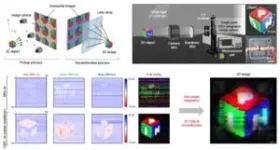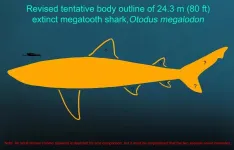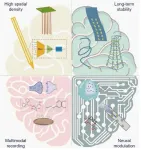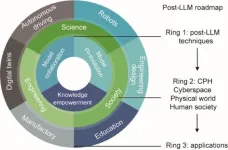(Press-News.org) Next-generation imaging technology is rapidly expanding beyond smartphones into intelligent devices, robotics, extended reality (XR) devices, healthcare, CCTV, and various other industries. At the core of these technological advances are highly efficient, ultra-compact image sensors that convert light signals into electrical signals. Image sensors capture and process visual information from objects and environments, enabling precise reconstruction of their shape, size, and spatial position.
Currently, commercial image sensors are primarily based on silicon semiconductors. However, research into next-generation image sensors utilizing two-dimensional (2D) semiconductor nanomaterials -potential replacements for silicon- is actively underway. These nanomaterials, composed of atomically thin layers just a few nanometers thick, offer exceptional optical properties and miniaturization potential, making them highly suitable for high-performance image sensors. However, maximizing their performance requires low-resistance electrodes capable of efficiently processing optical signals. Conventional 2D semiconductor-based sensors face challenges in achieving low resistance electrodes, resulting in poor optical signal processing efficiency, which has been a major obstacle to commercialization.
Do Kyung Hwang (Post-Silicon Semiconductor Institute, KIST; KU-KIST Graduate School, KIST School) and Dr. Min-Chul Park (Post-Silicon Semiconductor Institute, KIST; Korea University, and Yonsei University), along with their joint research team at the Korea Institute of Science and Technology (KIST, President Sang-Rok Oh), have successfully developed an innovative electrode material called Conductive-Bridge Interlayer Contact (CBIC), enabling the realization of a 2D semiconductor-based image sensor with high optical signal efficiency. By incorporating gold nanoparticles within the electrode, the team significantly reduced its resistance, leading to a substantial improvement in the performance of 2D semiconductor image sensor. Furthermore, they effectively addressed the issue of Fermi level pinning, a common challenge in conventional electrode materials, thereby further enhancing the sensor's optical signal efficiency.
In particular, the team applied this technology to successfully implement integral imaging based three-dimensional (3D) imaging and glasses-free display technology, inspired by the compound eye structure of dragonfly. Using integral imaging technology, they achieved the acquisition and reproduction of RGB full-color 3D images, enabling the recording and reconstruction of 3D object shapes. In the future, these high-performance image sensors are expected to be widely used in various advanced industries, including XR devices, artificial intelligence (AI), and autonomous driving systems.
"By overcoming the technical limitations caused by electrode issues in existing 2D semiconductor devices, this research is expected to significantly accelerate the industrialization of next-generation imaging system technologies, which offer advantages in light absorption and miniaturization," said Dr. Do Kyung Hwang. He further emphasized the scalability of the research, stating, "The developed electrode material is easy to fabricate and scalable to large areas, making it widely applicable to various semiconductor-based optoelectronic devices." Dr. Min-Chul Park added, "2D semiconductor-based optoelectronic devices that overcome the challenge of Fermi level pinning will have a significant impact across industries that demand ultra-compact, ultra-high-resolution, and high-performance visual sensors in the future."
###
KIST was established in 1966 as the first government-funded research institute in Korea. KIST now strives to solve national and social challenges and secure growth engines through leading and innovative research. For more information, please visit KIST’s website at https://www.kist.re.kr/eng/index.do
This research was supported by the Ministry of Science and ICT (Minister Yoo Sang-im) and the Ministry of Culture, Sports and Tourism (Minister Yoo Yoo-chon) through the KIST Major Project, the National Research Foundation of Korea Individual Research (RS-2023-NR077025), the IITP ITRC Research and Development Project (IITP-2023-RS-00258639), and the Korea Creative Content Agency Culture and Technology Research and Development Project (R2020040080, RS-2020-KC000685). The results of this research were published online in Nature Electronics.
END
KIST develops high-performance sensor based on two-dimensional semiconductor
Dramatic improvement in sensor performance by overcoming high resistance and Fermi level pinning
2025-03-10
ELSE PRESS RELEASES FROM THIS DATE:
New study links sleep debt and night shifts to increased infection risk among nurses
2025-03-10
A new study examining the effects of sleep patterns and shift work on the immune system has found that sleep debt and night shifts increase the risk of several common infections in nurses.
Modern society relies on shift work, which requires employees to work outside of traditional hours. While essential in sectors such as healthcare, growing evidence suggests that these work patterns may negatively impact worker’s health.
This study, which analysed self-reported data from 1,335 Norwegian nurses, found that shift work – particularly night shifts – was associated with a higher risk of several infections, including the ...
Megalodon’s body size and form uncover why certain aquatic vertebrates can achieve gigantism
2025-03-09
CHICAGO — A new scientific study provides many new insights into the biology of the prehistoric gigantic shark, Megalodon or megatooth shark, which lived nearly worldwide 15-3.6 million years ago. Paleobiology professor Kenshu Shimada of DePaul University led the study along with 28 other shark, fossil, and vertebrate anatomy experts around the globe. Findings from the study will be published in the journal “Palaeontologia Electronica.”
Formally called Otodus megalodon, it is primarily known only from its serrated teeth, vertebrae, ...
A longer, sleeker super predator: Megalodon’s true form
2025-03-09
The megalodon has long been imagined as an enormous great white shark, but new research suggests that perception is all wrong. The study finds the prehistoric hunter had a much longer body—closer in shape to a lemon shark or even a large whale.
The study team, which included researchers from University of California, Riverside and across the globe, used a novel approach to estimate the shark’s total body length, moving beyond traditional methods that rely primarily on tooth size. By examining megalodon’s vertebral column and comparing ...
Walking, moving more may lower risk of cardiovascular death for women with cancer history
2025-03-09
Research Highlights:
Increased physical activity including taking more daily steps was linked to a lower risk of death from cardiovascular disease among postmenopausal women with a history of cancer.
The study found that engaging in one hour per day of moderate to vigorous physical activity reduced participants’ risk of death from any cause by 40% and risk of death from cardiovascular disease by 60%.
Each additional 2,500 steps per day for a participant was associated with a 34% reduction in risk of death from cardiovascular disease.
Note: The study featured in this news release is a research abstract. Abstracts presented ...
Intracortical neural interfaces: Advancing technologies for freely moving animals
2025-03-09
A recent study published in Engineering delves into the latest progress in intracortical neural interface technologies for freely moving animals. These interfaces, which establish a connection between the nervous system and external devices, have the potential to revolutionize neuroscience research and clinical medicine.
The researchers, led by Xinxia Cai, Zhaojie Xu and Yirong Wu, analyzed four key technological directions for ideal implantable neural interface devices: higher spatial density, improved biocompatibility, enhanced multimodal detection of electrical/neurotransmitter signals, and more effective neural modulation.
In terms of high spatial density, microelectrode ...
Post-LLM era: New horizons for AI with knowledge, collaboration, and co-evolution
2025-03-08
A recent paper published in the journal Engineering delves into the future of artificial intelligence (AI) beyond large language models (LLMs). LLMs have made remarkable progress in multimodal tasks, yet they face limitations such as outdated information, hallucinations, inefficiency, and a lack of interpretability. To address these issues, researchers explore three key directions: knowledge empowerment, model collaboration, and model co-evolution.
Knowledge empowerment aims to integrate external knowledge into LLMs. This can be achieved through various methods, including integrating knowledge ...
“Sloshing” from celestial collisions solves mystery of how galactic clusters stay hot
2025-03-08
Tokyo, Japan – The XRISM collaboration have discovered flows of hot gas in the core of the Centaurus Cluster. By comparing state-of-the-art X-ray measurements from the XRISM satellite with numerical simulations, they showed this is evidence for collisions between galaxy clusters, causing gas inside to “slosh”. This solves the longstanding mystery of how cluster cores stay hot, and sheds light on how our universe continues to evolve.
Astronomers have long envisioned how vast gravitational forces ...
Children poisoned by the synthetic opioid, fentanyl, has risen in the U.S. – eight years of national data shows
2025-03-08
Incidents of children in the U.S. being poisoned by the synthetic opioid fentanyl “increased and became more severe”, a new study reveals.
Launched today as Congress continues to review the HALT Fentanyl Act, the research follows an analysis of nonfatal fentanyl pediatric (aged 0-19) exposures reported to poison centers in 49 U.S. states from 2015 through to 2023.
In total, some 3,009 cases were detailed across the eight-year period.
In 2023 alone, 44.6% were life-threatening incidents in which there was extreme harm ...
USC researchers observe mice may have a form of first aid
2025-03-08
Humans may not be the only ones who aid their friends when they’re hurt. Mice may do it, too, as shown by a new research study led by scientists at the Keck School of Medicine of USC published recently in Science.
Scientists have been trying to understand why social mammals appear to help injured members of their species. There are numerous factors that determine empathetic behavior and social bonding in mammals, said Li Zhang, the principal investigator of the study and professor of physiology and neuroscience ...
VUMC to develop AI technology for therapeutic antibody discovery
2025-03-07
An ambitious project led by Vanderbilt University Medical Center investigators aims to use artificial intelligence technologies to generate antibody therapies against any antigen target of interest.
VUMC has been awarded up to $30 million from the Advanced Research Projects Agency for Health (ARPA-H) to build a massive antibody-antigen atlas, develop AI-based algorithms to engineer antigen-specific antibodies, and apply the AI technology to identify and develop potential therapeutic antibodies.
ARPA-H is an ...
LAST 30 PRESS RELEASES:
Fame itself may be critical factor in shortening singers’ lives
Daily coffee drinking may slow biological ageing of people with major mental illness
New highly efficient material turns motion into power – without toxic lead
The DEVILS in the details: New research reveals how the cosmic landscape impacts the galaxy lifecycle
After nearly 100 years, scientists may have detected dark matter
Gender imbalance hinders equitable environmental governance, say UN scientists
Six University of Tennessee faculty among world’s most highly cited researchers
A type of immune cell could hold a key to preventing scar tissue buildup in wounds
Mountains as water towers: New research highlights warming differences between high and low elevations
University of Tennessee secures $1 million NSF grant to build semiconductor workforce pipeline
Biochar shows powerful potential to build cleaner and more sustainable cities worldwide
UT Health San Antonio leads $4 million study on glucagon hormone’s role in diabetes, obesity
65-year-old framework challenged by modern research
AI tool helps visually impaired users ‘feel’ where objects are in real time
Collaborating minds think alike, processing information in similar ways in a shared task
Routine first trimester ultrasounds lead to earlier detection of fetal anomalies
Royal recognition for university’s dementia work
It’s a bird, it’s a drone, it’s both: AI tech monitors turkey behavior
Bormioli Luigi renews LionGlass deal with Penn State after successful trial run
Are developers prepared to control super-intelligent AI?
A step toward practical photonic quantum neural networks
Study identifies target for disease hyper progression after immunotherapy in kidney cancer
Concordia researchers identify key marker linking coronary artery disease to cognitive decline
HER2-targeted therapy shows promising results in rare bile duct cancers
Metabolic roots of memory loss
Clinical outcomes and in-hospital mortality rate following heart valve replacements at a tertiary-care hospital
Too sick to socialize: How the brain and immune system promote staying in bed
Seal milk more refined than breast milk
Veterans with cardiometabolic conditions face significant risk of dying during extreme heat events
How plants search for nutrients
[Press-News.org] KIST develops high-performance sensor based on two-dimensional semiconductorDramatic improvement in sensor performance by overcoming high resistance and Fermi level pinning








